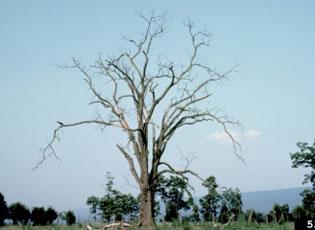Ophiostoma ulmi (Buisman) Nannf. and Ophiostoma novo-ulmi Brasier (ITIS)
Dutch elm disease (DED)
Unknown, possibly Asia (Brasier et al. 2001)
First discovered in the U.S. during the 1930s (Olson et al.)
Introduced accidentally on diseased logs imported from Europe (Flores 2006)
Lethal fungal disease of elm trees (particularly American elms (Ulmus americana), which are more susceptible to the disease than other elm species) (Olson et al.)
Has been found throughout the entire U.S. except for the desert Southwest

Dutch elm disease symptoms
Roland J. Stipes Virginia Polytechnic Institute and State University
Distribution / Maps / Survey Status
All Resources
Selected Resources
The section below contains highly relevant resources for this species, organized by source.
Council or Task Force
Partnership
Federal Government
International Government
State and Local Government
Academic
Brasier, C. M., and K. W. Buck. 2001. Rapid evolutionary changes in a globally invading fungal pathogen. Biological Invasions 3:223-233.
Flores, A. 2006. Dutch elm disease update.Agricultural Research 54(6):18.
Integrated Taxonomic Information System. Ophiostoma spp. [Accessed Aug 31, 2023].
Olson, B., S. von Broembsen, and T. Royer. Dutch Elm Disease and Its Control. Oklahoma Cooperative Extension Service. EPP-7602.
